Anti-arrhythmic effects of hypercalcemia in hyperkalemic, Langendorff-perfused mouse hearts
- Authors:
- Gary Tse
- Bing Sun
- Sheung Ting Wong
- Vivian Tse
- Jie Ming Yeo
-
Affiliations: School of Biomedical Sciences, Li Ka Shing Faculty of Medicine, University of Hong Kong, Hong Kong, SAR, P.R. China, Department of Cardiology, Tongji University Affiliated Tongji Hospital, Shanghai 200065, P.R. China, School of Medicine, Imperial College London, London SW7 2AZ, UK, Department of Physiology, McGill University, Montreal, Quebec H3G 1Y6, Canada - Published online on: August 2, 2016 https://doi.org/10.3892/br.2016.735
- Pages: 301-310
-
Copyright : © Tse et al. This is an open access article distributed under the terms of Creative Commons Attribution License [CC BY 4.0].
This article is mentioned in:
Abstract
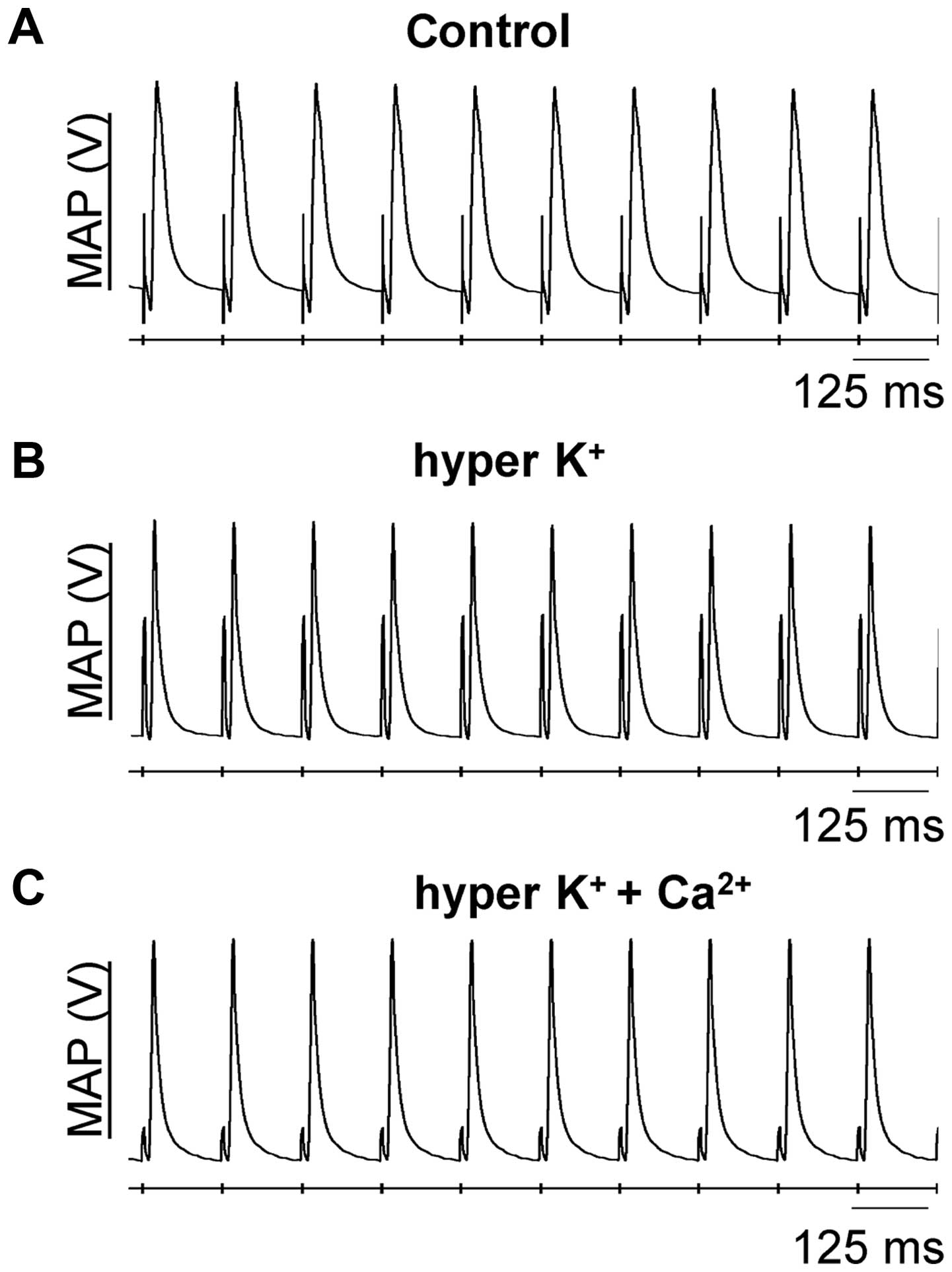 |
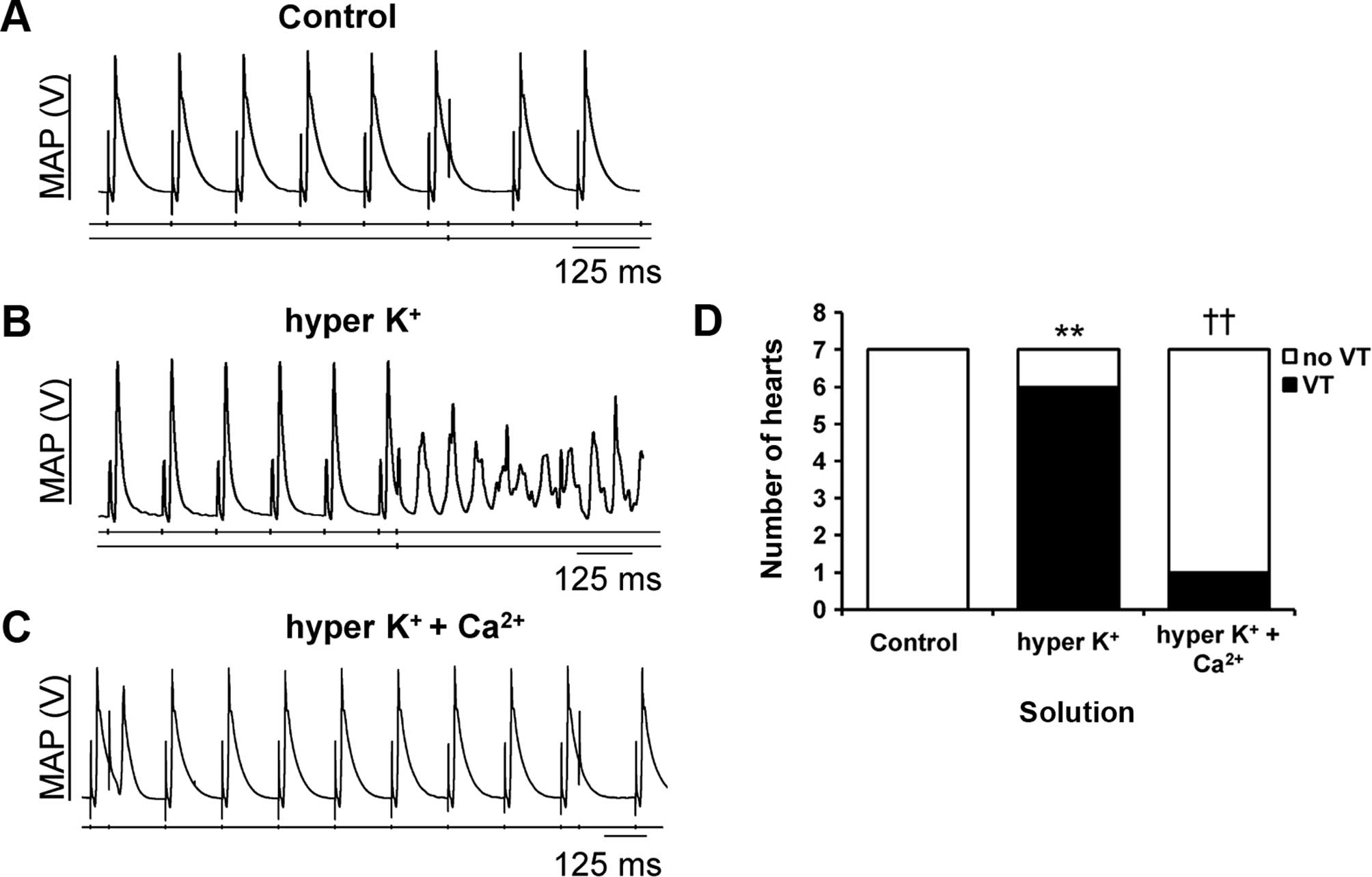 |
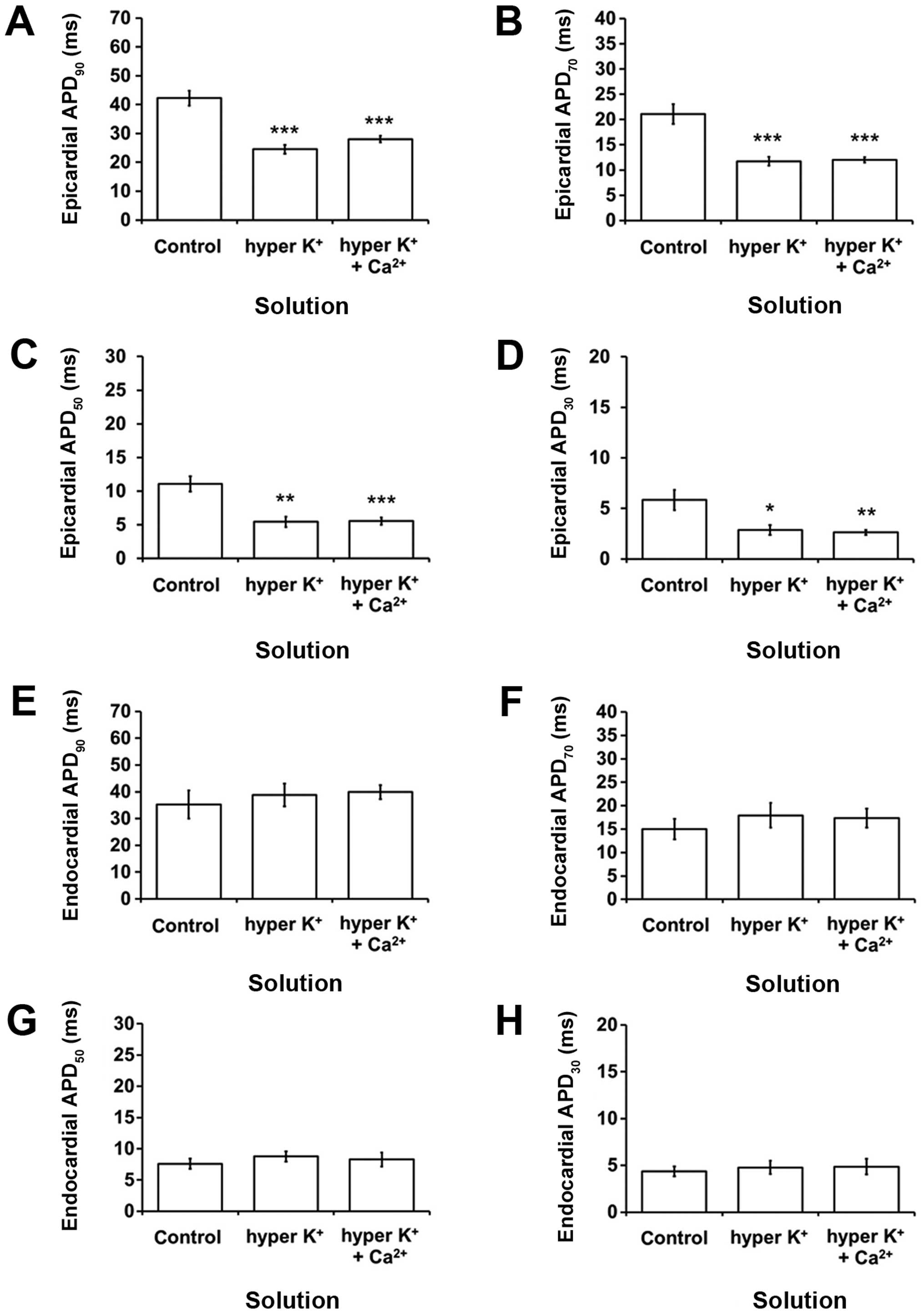 |
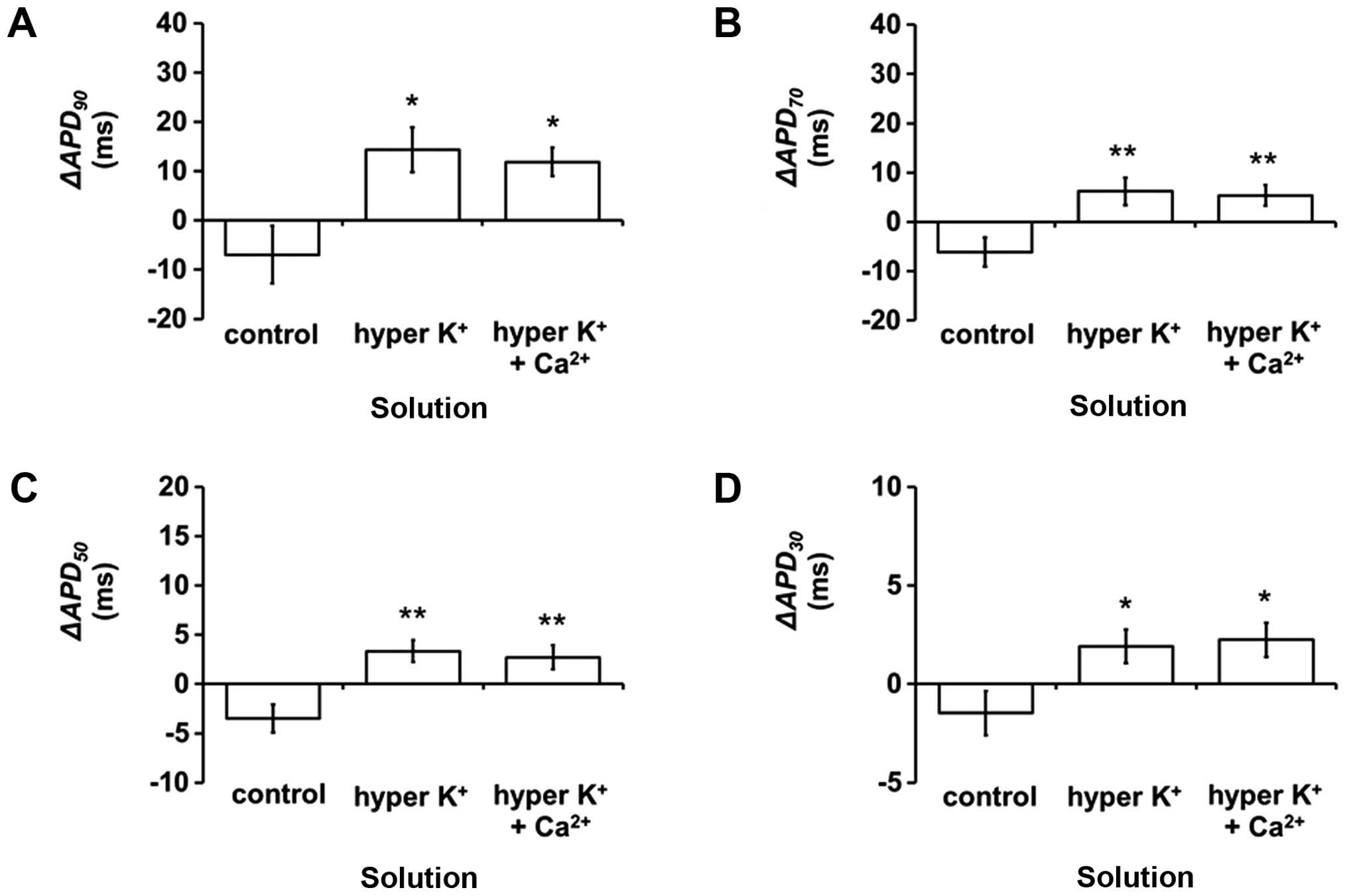 |
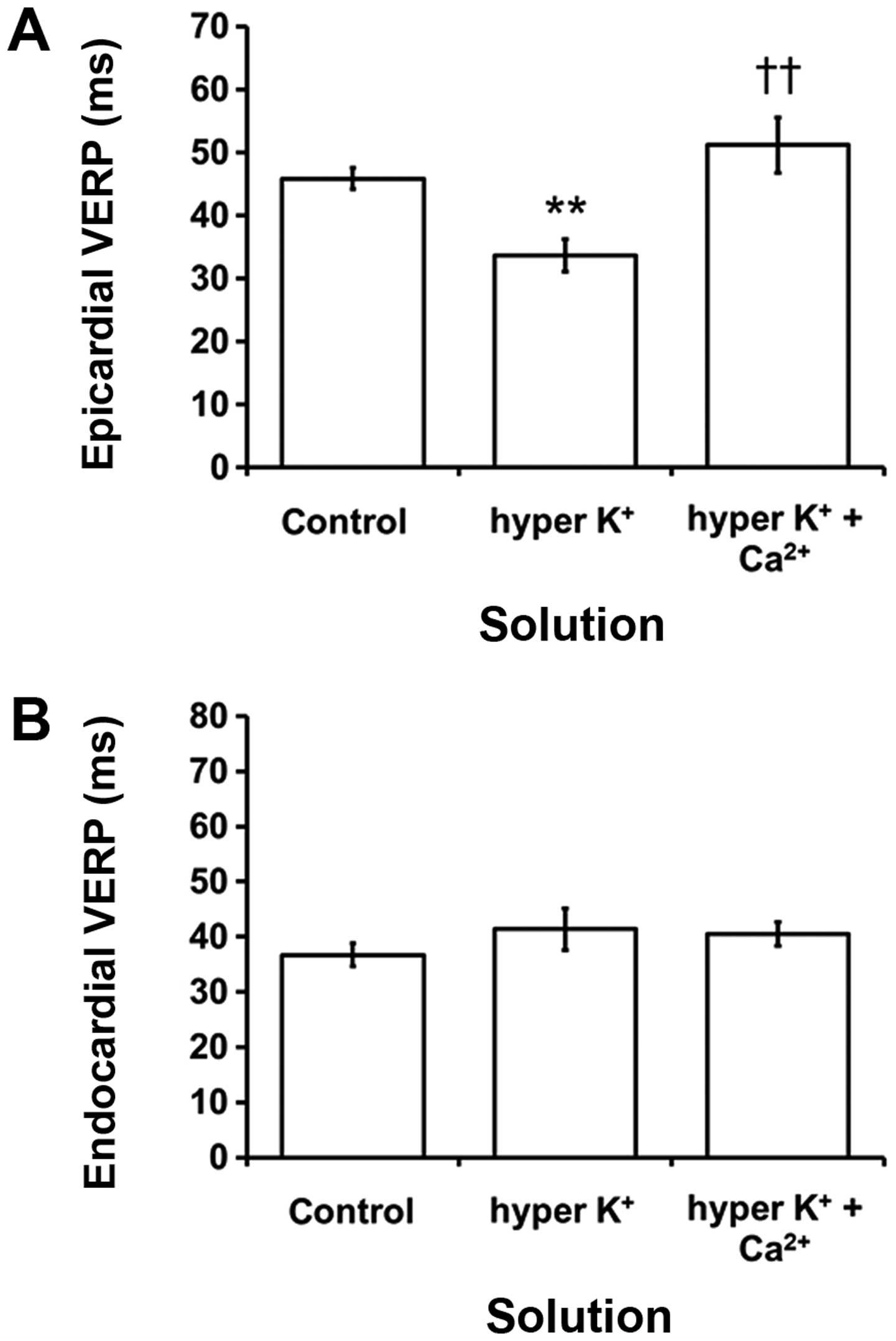 |
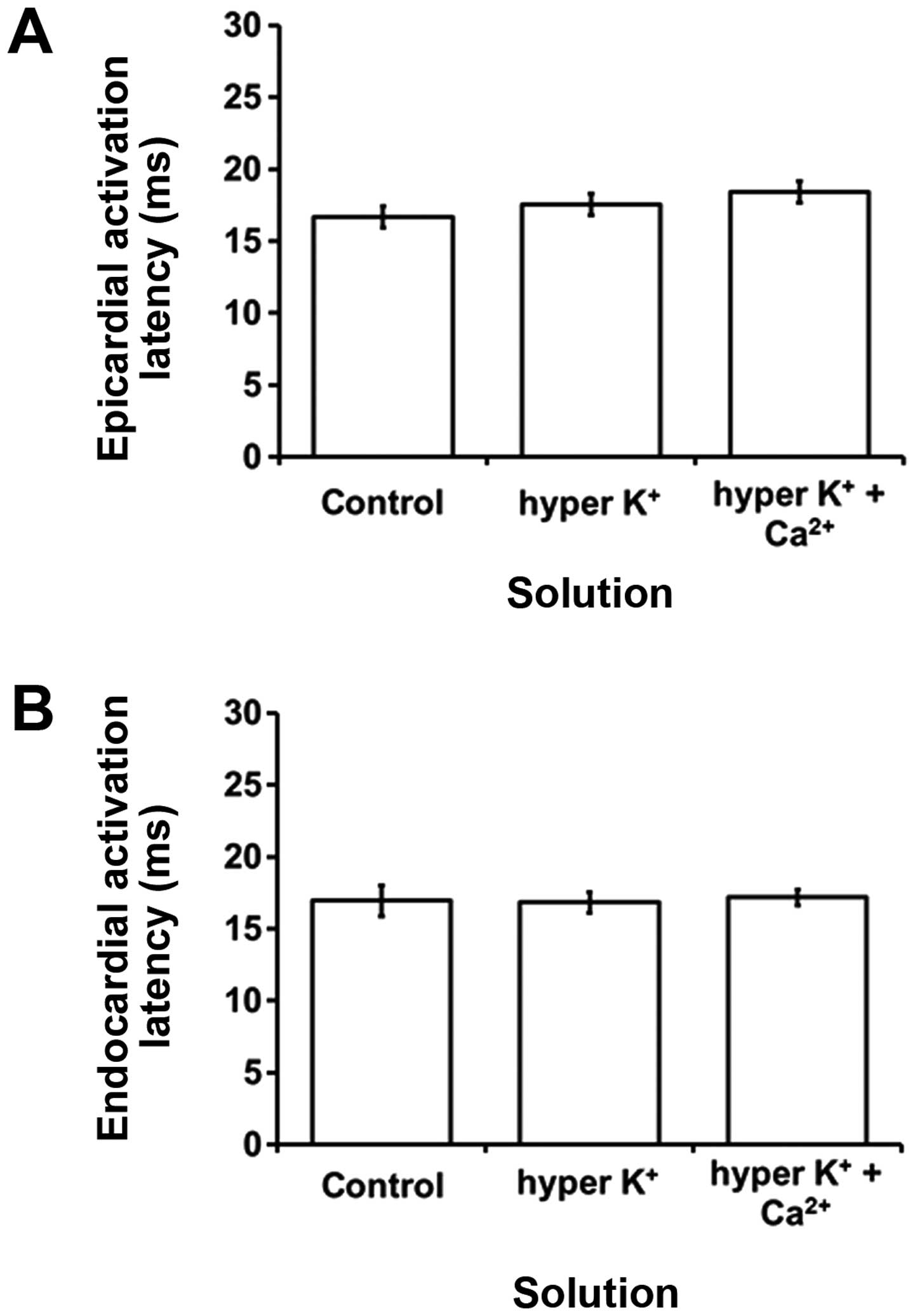 |
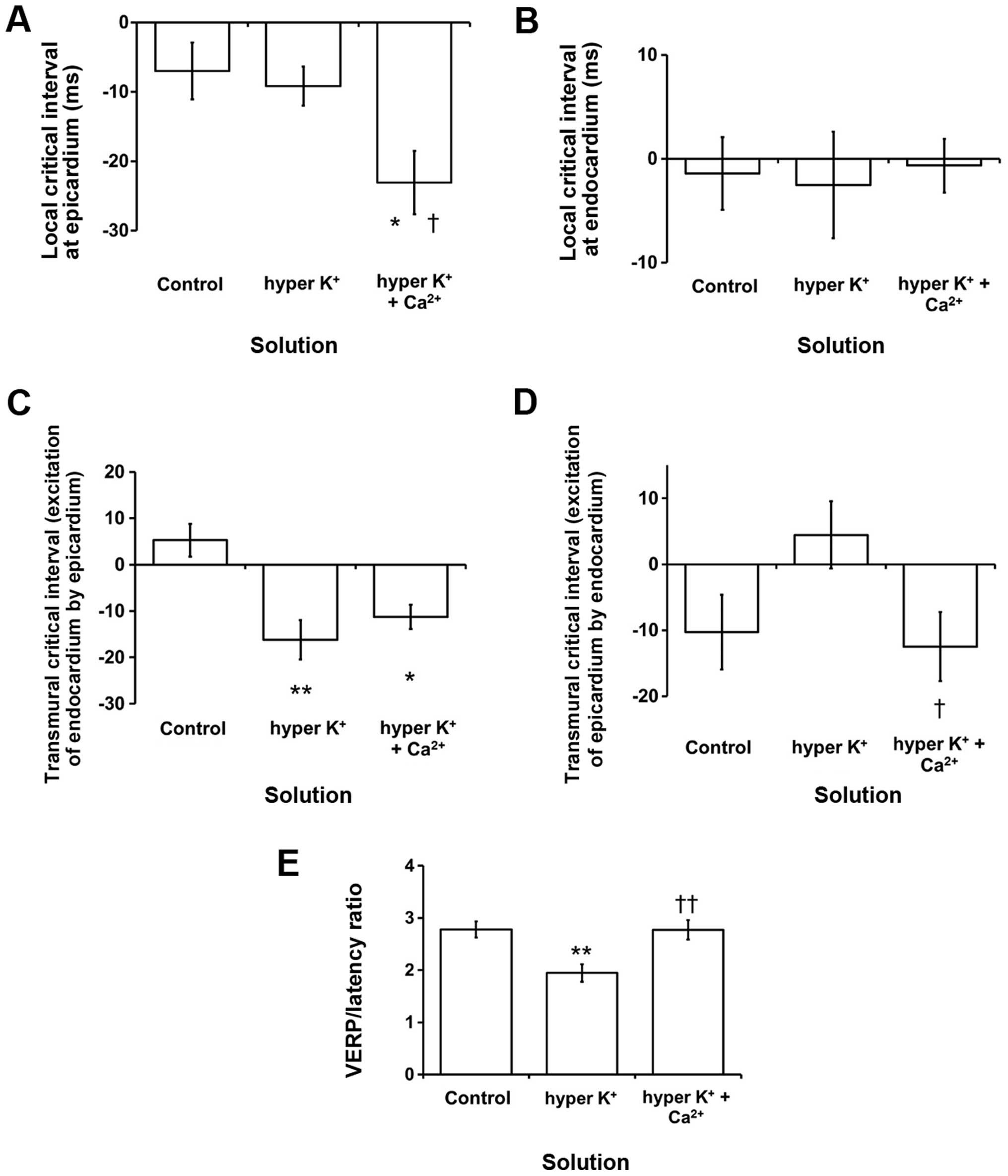 |
|
No authors listed, . Guidelines 2000 for Cardiopulmonary Resuscitation and Emergency Cardiovascular Care. Part 8: Advanced challenges in resuscitation: section 1: Life-threatening electrolyte abnormalities. The American Heart Association in collaboration with the International Liaison Committee on Resuscitation. Circulation. 102(Suppl 8): I217–I222. 2000.PubMed/NCBI | |
|
Gettes LS: Electrolyte abnormalities underlying lethal and ventricular arrhythmias. Circulation. 85(Suppl 1): I70–I76. 1992.PubMed/NCBI | |
|
Friedensohn A, Faibel HE, Bairey O, Goldbourt U and Schlesinger Z: Malignant arrhythmias in relation to values of serum potassium in patients with acute myocardial infarction. Int J Cardiol. 32:331–338. 1991. View Article : Google Scholar : PubMed/NCBI | |
|
Ahmed MI, Ekundayo OJ, Mujib M, Campbell RC, Sanders PW, Pitt B, Perry GJ, Bakris G, Aban I, Love TE, et al: Mild hyperkalemia and outcomes in chronic heart failure: A propensity matched study. Int J Cardiol. 144:383–388. 2010. View Article : Google Scholar : PubMed/NCBI | |
|
Bashour TT and Cheng TO: Evidence for specialized atrioventricular conduction in hyperkalemia. J Electrocardiol. 8:65–68. 1975. View Article : Google Scholar : PubMed/NCBI | |
|
Dittrich KL and Walls RM: Hyperkalemia: ECG manifestations and clinical considerations. J Emerg Med. 4:449–455. 1986. View Article : Google Scholar : PubMed/NCBI | |
|
Freeman K, Feldman JA, Mitchell P, Donovan J, Dyer KS, Eliseo L, White LF and Temin ES: Effects of presentation and electrocardiogram on time to treatment of hyperkalemia. Acad Emerg Med. 15:239–249. 2008. View Article : Google Scholar : PubMed/NCBI | |
|
Cooper WD, Kuan P, Reuben SR and VandenBurg MJ: Cardiac arrhythmias following acute myocardial infarction: Associations with the serum potassium level and prior diuretic therapy. Eur Heart J. 5:464–469. 1984.PubMed/NCBI | |
|
Weiner ID and Wingo CS: Hyperkalemia: A potential silent killer. J Am Soc Nephrol. 9:1535–1543. 1998.PubMed/NCBI | |
|
Sood MM and Pauly RP: A case of severe hyperkalemia: Fast, safe and effective treatment is required. J Crit Care. 23:431–433. 2008. View Article : Google Scholar : PubMed/NCBI | |
|
Kiewiet RM, Ponssen HH, Janssens EN and Fels PW: Ventricular fibrillation in hypercalcaemic crisis due to primary hyperparathyroidism. Neth J Med. 62:94–96. 2004.PubMed/NCBI | |
|
Curione M, Letizia C, Amato S, Di Bona S, Di Fazio F, Minisola S, Mazzuoli G and D'Erasmo E: Increased risk of cardiac death in primary hyperparathyroidism: What is a role of electrical instability? Int J Cardiol. 121:200–202. 2007. View Article : Google Scholar : PubMed/NCBI | |
|
George SA, Sciuto KJ, Lin J, Salama ME, Keener JP, Gourdie RG and Poelzing S: Extracellular sodium and potassium levels modulate cardiac conduction in mice heterozygous null for the Connexin43 gene. Pflugers Arch. 467:2287–2297. 2015. View Article : Google Scholar : PubMed/NCBI | |
|
Kodama I, Wilde A, Janse MJ, Durrer D and Yamada K: Combined effects of hypoxia, hyperkalemia and acidosis on membrane action potential and excitability of guinea-pig ventricular muscle. J Mol Cell Cardiol. 16:247–259. 1984. View Article : Google Scholar : PubMed/NCBI | |
|
Leitch SP and Paterson DJ: Role of Ca2+ in protecting the heart from hyperkalemia and acidosis in the rabbit: Implications for exercise. J Appl Physiol (1985). 77:2391–2399. 1994.PubMed/NCBI | |
|
Piktel JS, Wan X, Infeld M, Rosenbaum D and Wilson LD: Beneficial effect of calcium treatment for hyperkalemia is mediated by calcium-dependent conduction, not ‘membrane stabilization’. Ann Emerg Med. 56:S92010. View Article : Google Scholar | |
|
Tse G and Yeo JM: Conduction abnormalities and ventricular arrhythmogenesis: The roles of sodium channels and gap junctions. Int J Cardiol Heart Vasc. 9:75–82. 2015.PubMed/NCBI | |
|
Choy L, Yeo JM, Tse V, Chan SP and Tse G: Cardiac disease and arrhythmogenesis: Mechanistic insights from mouse models. Int J Cardiol Heart Vasc. 12:1–10. 2016. | |
|
Tse G: Both transmural dispersion of repolarization and transmural dispersion of refractoriness are poor predictors of arrhythmogenicity: A role for the index of Cardiac Electrophysiological Balance (QT/QRS)? J Geriatr Cardiol. (In press). PubMed/NCBI | |
|
Tse G, Lai ET, Yeo JM and Yan BP: Electrophysiological mechanisms of Bayés syndrome: Insights from clinical and mouse studies. Front Physiol. May 31–2016.(Epub ahead of print). View Article : Google Scholar | |
|
Tse G, Lai ET, Lee AP, Yan BP and Wong SH: Electrophysiological mechanisms of gastrointestinal arrhythmogenesis: Lessons from the heart. Front Physiol. (In press). | |
|
Tse G, Lai TH, Yeo JM, Tse V and Wong SH: Mechanisms of electrical activation and conduction in the gastrointestinal system: Lessons from cardiac electrophysiology. Front Physiol. May 31–2016.(Epub ahead of print). View Article : Google Scholar | |
|
Tse G, Lai ET, Tse V and Yeo JM: Molecular and electrophysiological mechanisms underlying cardiac arrhythmogenesis in diabetes mellitus. J Diabetes Res. (In press). | |
|
Tse G and Yan BP: Novel arrhythmic risk markers incorporating QRS dispersion: QRSd x (Tpeak-Tend)/QRS and QRSd x (Tpeak-Tend)/(QT x QRS). Ann Noninvasive Electrocardiol. (In press). | |
|
Tse G: Novel conduction-repolarization indices for the stratification of arrhythmic risk. J Geriatr Cardiol. (In press). PubMed/NCBI | |
|
Tse G: (Tpeak-Tend)/QRS and (Tpeak-Tend)/(QT x QRS): Novel markers for predicting arrhythmic risk in Brugada syndrome. Europace. (In press). | |
|
Tse G, Wong ST, Tse V, Lee YT, Lin HY and Yeo JM: Cardiac dynamics: alternans and arrhythmogenesis. J Arrhythm. Mar 28–2016.(Epub ahead of print). View Article : Google Scholar : PubMed/NCBI | |
|
Tse G: Mechanisms of cardiac arrhythmias. J Arrhythm. 32:75–81. 2016. View Article : Google Scholar : PubMed/NCBI | |
|
Tse G, Tse V and Yeo JM: Ventricular anti-arrhythmic effects of heptanol in hypokalaemic, Langendorff-perfused mouse hearts. Biomed Rep. 4:313–324. 2016.PubMed/NCBI | |
|
Tse G, Wong ST, Tse V and Yeo JM: Restitution analysis of alternans using dynamic pacing and its comparison with S1S2 restitution in heptanol-treated, hypokalaemic Langendorff-perfused mouse hearts. Biomed Rep. 4:673–680. 2016.PubMed/NCBI | |
|
Tse G, Hothi SS, Grace AA and Huang CL: Ventricular arrhythmogenesis following slowed conduction in heptanol-treated, Langendorff-perfused mouse hearts. J Physiol Sci. 62:79–92. 2012. View Article : Google Scholar : PubMed/NCBI | |
|
Tse G, Tse V, Yeo JM and Sun B: Atrial anti-arrhythmic effects of heptanol in Langendorff-perfused mouse hearts. PLoS One. 11:e01488582016. View Article : Google Scholar : PubMed/NCBI | |
|
Hogan PM and Spitzer KW: Manganese amd electrogenic phenomena in canine Purkinje fibers. Circ Res. 36:377–391. 1975. View Article : Google Scholar : PubMed/NCBI | |
|
Balasubramaniam R, Chawla S, Mackenzie L, Schwiening CJ, Grace AA and Huang CL: Nifedipine and diltiazem suppress ventricular arrhythmogenesis and calcium release in mouse hearts. Pflugers Arch. 449:150–158. 2004. View Article : Google Scholar : PubMed/NCBI | |
|
Balasubramaniam R, Grace AA, Saumarez RC, Vandenberg JI and Huang CL: Electrogram prolongation and nifedipine-suppressible ventricular arrhythmias in mice following targeted disruption of KCNE1. J Physiol. 552:535–546. 2003. View Article : Google Scholar : PubMed/NCBI | |
|
Head CE, Balasubramaniam R, Thomas G, Goddard CA, Lei M, Colledge WH, Grace AA and Huang CL: Paced electrogram fractionation analysis of arrhythmogenic tendency in DeltaKPQ Scn5a mice. J Cardiovasc Electrophysiol. 16:1329–1340. 2005. View Article : Google Scholar : PubMed/NCBI | |
|
Knollmann BC, Katchman AN and Franz MR: Monophasic action potential recordings from intact mouse heart: Validation, regional heterogeneity, and relation to refractoriness. J Cardiovasc Electrophysiol. 12:1286–1294. 2001. View Article : Google Scholar : PubMed/NCBI | |
|
Gussak I, Chaitman BR, Kopecky SL and Nerbonne JM: Rapid ventricular repolarization in rodents: Electrocardiographic manifestations, molecular mechanisms, and clinical insights. J Electrocardiol. 33:159–170. 2000. View Article : Google Scholar : PubMed/NCBI | |
|
Fabritz L, Kirchhof P, Franz MR, Eckardt L, Mönnig G, Milberg P, Breithardt G and Haverkamp W: Prolonged action potential durations, increased dispersion of repolarization, and polymorphic ventricular tachycardia in a mouse model of proarrhythmia. Basic Res Cardiol. 98:25–32. 2003. View Article : Google Scholar : PubMed/NCBI | |
|
Sabir IN, Fraser JA, Killeen MJ, Grace AA and Huang CL: The contribution of refractoriness to arrhythmic substrate in hypokalemic Langendorff-perfused murine hearts. Pflugers Arch. 454:209–222. 2007. View Article : Google Scholar : PubMed/NCBI | |
|
Kléber AG and Rudy Y: Basic mechanisms of cardiac impulse propagation and associated arrhythmias. Physiol Rev. 84:431–488. 2004. View Article : Google Scholar : PubMed/NCBI | |
|
Thomas GP, Howlett SE and Ferrier GR: Saralasin suppresses arrhythmias in an isolated guinea pig ventricular free wall model of simulated ischemia and reperfusion. J Pharmacol Exp Ther. 274:1379–1386. 1995.PubMed/NCBI | |
|
Nolan JP, Soar J, Zideman DA, Biarent D, Bossaert LL, Deakin C, Koster RW, Wyllie J and Böttiger B: ERC Guidelines Writing Group: European Resuscitation Council Guidelines for Resuscitation 2010 Section 1. Executive summary. Resuscitation. 81:1219–1276. 2010. | |
|
Tse G, Wong ST, Tse V and Yeo JM: Depolarization vs. repolarization: What is the mechanism of ventricular arrhythmogenesis underlying sodium channel haploinsufficiency in mouse hearts? Acta Physiol (Oxf). Apr 30–2016. View Article : Google Scholar : PubMed/NCBI | |
|
Chen Z, Sun B, Tse G, Jiang J and Xu W: Reversibility of both sinus node dysfunction and reduced HCN4 mRNA expression level in an atrial tachycardia pacing model of tachycardia-bradycardia syndrome in rabbit hearts. Int J Clin Exp Pathol. (In press). | |
|
Tse G, Wong ST, Tse V and Yeo JM: Determination of action potential wavelength restitution in Scn5a +/− mouse hearts modelling human Brugada syndrome. J Physiol. (In press). | |
|
Antzelevitch C: Cellular basis for the repolarization waves of the ECG. Ann N Y Acad Sci. 1080:268–281. 2006. View Article : Google Scholar : PubMed/NCBI | |
|
Fisch C: Relation of electrolyte disturbances to cardiac arrhythmias. Circulation. 47:408–419. 1973. View Article : Google Scholar : PubMed/NCBI | |
|
Sanguinetti MC and Jurkiewicz NK: Role of external Ca2+ and K+ in gating of cardiac delayed rectifier K+ currents. Pflugers Arch. 420:180–186. 1992. View Article : Google Scholar : PubMed/NCBI | |
|
Sanguinetti MC, Jiang C, Curran ME and Keating MT: A mechanistic link between an inherited and an acquired cardiac arrhythmia: HERG encodes the IKr potassium channel. Cell. 81:299–307. 1995. View Article : Google Scholar : PubMed/NCBI | |
|
Kishida H, Surawicz B and Fu LT: Effects of K+ and K+-induced polarization on (dV/dt)max, threshold potential, and membrane input resistance in guinea pig and cat ventricular myocardium. Circ Res. 44:800–814. 1979. View Article : Google Scholar : PubMed/NCBI | |
|
Dominguez G and Fozzard HA: Influence of extracellular K+ concentration on cable properties and excitability of sheep cardiac Purkinje fibers. Circ Res. 26:565–574. 1970. View Article : Google Scholar : PubMed/NCBI | |
|
Ettinger PO, Regan TJ and Oldewurtel HA: Hyperkalemia, cardiac conduction, and the electrocardiogram: A review. Am Heart J. 88:360–371. 1974. View Article : Google Scholar : PubMed/NCBI | |
|
Killeen MJ, Thomas G, Gurung IS, Goddard CA, Fraser JA, MahautSmith MP, Colledge WH, Grace AA and Huang CL: Arrhythmogenic mechanisms in the isolated perfused hypokalaemic murine heart. Acta Physiol (Oxf). 189:33–46. 2007. View Article : Google Scholar : PubMed/NCBI | |
|
Nerbonne JM and Guo W: Heterogeneous expression of voltage-gated potassium channels in the heart: Roles in normal excitation and arrhythmias. J Cardiovasc Electrophysiol. 13:406–409. 2002. View Article : Google Scholar : PubMed/NCBI | |
|
Antzelevitch C: Transmural dispersion of repolarization and the T wave. Cardiovasc Res. 50:426–431. 2001. View Article : Google Scholar : PubMed/NCBI | |
|
Yan GX and Martin J: Electrocardiographic T wave: A symbol of transmural dispersion of repolarization in the ventricles. J Cardiovasc Electrophysiol. 14:639–640. 2003. View Article : Google Scholar : PubMed/NCBI | |
|
Mines GR: On dynamic equilibrium in the heart. J Physiol. 46:349–383. 1913. View Article : Google Scholar : PubMed/NCBI | |
|
Weidmann S: Effects of calcium ions and local anesthetics on electrical properties of Purkinje fibres. J Physiol. 129:568–582. 1955. View Article : Google Scholar : PubMed/NCBI | |
|
Hélie F, Cossette J, Vermeulen M and Cardinal R: Differential effects of lignocaine and hypercalcaemia on anisotropic conduction and reentry in the ischaemically damaged canine ventricle. Cardiovasc Res. 29:359–372. 1995. View Article : Google Scholar : PubMed/NCBI | |
|
Corlew DS, Bryda SL, Bradley EL III and DiGirolamo M: Observations on the course of untreated primary hyperparathyroidism. Surgery. 98:1064–1071. 1985.PubMed/NCBI | |
|
Rosenqvist M, Nordenström J, Andersson M and Edhag OK: Cardiac conduction in patients with hypercalcaemia due to primary hyperparathyroidism. Clin Endocrinol (Oxf). 37:29–33. 1992. View Article : Google Scholar : PubMed/NCBI | |
|
Parham WA, Mehdirad AA, Biermann KM and Fredman CS: Hyperkalemia revisited. Tex Heart Inst J. 33:40–47. 2006.PubMed/NCBI | |
|
Rumancik WM, Denlinger JK, Nahrwold ML and Falk RB Jr: The QT interval and serum ionized calcium. JAMA. 240:366–368. 1978. View Article : Google Scholar : PubMed/NCBI | |
|
Scheidegger D and Drop LJ: The relationship between duration of Q-T interval and plasma ionized calcium concentration: Experiments with acute, steady-state [Ca++] changes in the dog. Anesthesiology. 51:143–148. 1979. View Article : Google Scholar : PubMed/NCBI | |
|
Wortsman J and Frank S: The QT interval in clinical hypercalcemia. Clin Cardiol. 4:87–90. 1981. View Article : Google Scholar : PubMed/NCBI | |
|
Killeen MJ, Thomas G, Sabir IN, Grace AA and Huang CL: Mouse models of ventricular arrhythmias. Acta Physiol (Oxf). 192:455–469. 2008. View Article : Google Scholar : PubMed/NCBI | |
|
Nerbonne JM and Kass RS: Molecular physiology of cardiac repolarization. Physiol Rev. 85:1205–1253. 2005. View Article : Google Scholar : PubMed/NCBI | |
|
Hsieh YC, Lin JC, Hung CY, Li CH, Lin SF, Yeh HI, Huang JL, Lo CP, Haugan K, Larsen BD, et al: Gap junction modifier rotigaptide decreases the susceptibility to ventricular arrhythmia by enhancing conduction velocity and suppressing discordant alternans during therapeutic hypothermia in isolated rabbit hearts. Heart Rhythm. 13:251–261. 2016. View Article : Google Scholar : PubMed/NCBI | |
|
Wu TJ, Lin SF, Weiss JN, Ting CT and Chen PS: Two types of ventricular fibrillation in isolated rabbit hearts: Importance of excitability and action potential duration restitution. Circulation. 106:1859–1866. 2002. View Article : Google Scholar : PubMed/NCBI | |
|
Osadchii OE: Effects of ventricular pacing protocol on electrical restitution assessments in guinea-pig heart. Exp Physiol. 97:807–821. 2012. View Article : Google Scholar : PubMed/NCBI | |
|
Osadchii OE, Larsen AP and Olesen SP: Predictive value of electrical restitution in hypokalemia-induced ventricular arrhythmogenicity. Am J Physiol Heart Circ Physiol. 298:H210–H220. 2010. View Article : Google Scholar : PubMed/NCBI | |
|
Osadchii OE: Mechanisms of hypokalemia-induced ventricular arrhythmogenicity. Fundam Clin Pharmacol. 24:547–559. 2010. View Article : Google Scholar : PubMed/NCBI | |
|
Osadchii OE, Bentzen BH and Olesen SP: Chamber-specific effects of hypokalaemia on ventricular arrhythmogenicity in isolated, perfused guinea-pig heart. Exp Physiol. 94:434–446. 2009. View Article : Google Scholar : PubMed/NCBI | |
|
Osadchii OE and Olesen SP: Electrophysiological determinants of hypokalaemia-induced arrhythmogenicity in the guinea-pig heart. Acta Physiol (Oxf). 197:273–287. 2009. View Article : Google Scholar : PubMed/NCBI | |
|
Osadchii OE: Flecainide attenuates rate adaptation of ventricular repolarization in guinea-pig heart. Scand Cardiovasc J. 50:28–35. 2016. View Article : Google Scholar : PubMed/NCBI | |
|
Osadchii OE: Impact of hypokalemia on electromechanical window, excitation wavelength and repolarization gradients in guinea-pig and rabbit hearts. PLoS One. 9:e1055992014. View Article : Google Scholar : PubMed/NCBI | |
|
Osadchii OE: Impaired epicardial activation-repolarization coupling contributes to the proarrhythmic effects of hypokalaemia and dofetilide in guinea pig ventricles. Acta Physiol (Oxf). 211:48–60. 2014. View Article : Google Scholar : PubMed/NCBI | |
|
Osadchii OE: Flecainide-induced proarrhythmia is attributed to abnormal changes in repolarization and refractoriness in perfused guinea-pig heart. J Cardiovasc Pharmacol. 60:456–466. 2012. View Article : Google Scholar : PubMed/NCBI | |
|
Hsieh YC, Lin SF, Lin TC, Ting CT and Wu TJ: Therapeutic hypothermia (30 degrees C) enhances arrhythmogenic substrates, including spatially discordant alternans, and facilitates pacing-induced ventricular fibrillation in isolated rabbit hearts. Circ J. 73:2214–2222. 2009. View Article : Google Scholar : PubMed/NCBI | |
|
Franz MR, Burkhoff D, Spurgeon H, Weisfeldt ML and Lakatta EG: In vitro validation of a new cardiac catheter technique for recording monophasic action potentials. Eur Heart J. 7:34–41. 1986.PubMed/NCBI | |
|
Hoffman BF, Cranefield PF, Lepeschkin E, Surawicz B and Herrlich HC: Comparison of cardiac monophasic action potentials recorded by intracellular and suction electrodes. Am J Physiol. 196:1297–1301. 1959.PubMed/NCBI | |
|
Tse G, Wong ST, Tse V and Yeo JM, Lin HY and Yeo JM: Monophasic action potential recordings: Which is the recording electrode? J Basic Clin Physiol Pharmacol. Apr 30–2016.(Epub ahead of print). View Article : Google Scholar : PubMed/NCBI | |
|
Tse G, Ali A, Alpendurada F, Prasad S, Raphael CE and Vassiliou V: Tuberculous Constrictive Pericarditis. Res Cardiovasc Med. 4:e296142015. View Article : Google Scholar : PubMed/NCBI | |
|
Tse G, Ali A, Prasad SK, Vassiliou V and Raphael CE: Atypical case of post-partum cardiomyopathy: an overlap syndrome with arrhythmogenic right ventricular cardiomyopathy? BJR|case reports. 1:201501822015. View Article : Google Scholar | |
|
Vassiliou V, Chin C, Perperoglou A, Tse G, Ali A, Raphael C, Jabbour A, Newby D, Pennell D, Dweck M and Prasad S: 93 Ejection Fraction by Cardiovascular Magnetic Resonance Predicts Adverse Outcomes Post Aortic Valve Replacement. Heart. 100(Suppl 3): A53–A54. 2014. View Article : Google Scholar | |
|
Kwong JS, Leithäuser B, Park JW and Yu CM: Diagnostic value of magnetocardiography in coronary artery disease and cardiac arrhythmias: A review of clinical data. Int J Cardiol. 167:1835–1842. 2013. View Article : Google Scholar : PubMed/NCBI | |
|
Steinhoff U, KnappeGrueneberg S, Schnabel A, Trahms L, Smith F, Langley P, Murray A and Koch H: Magnetocardiography for pharmacology safety studies requiring high patient throughput and reliability. J Electrocardiol. 37(Suppl): 187–192. 2004. View Article : Google Scholar : PubMed/NCBI | |
|
Yoshida K, Ogata K, Inaba T, Nakazawa Y, Ito Y, Yamaguchi I, Kandori A and Aonuma K: Ability of magnetocardiography to detect regional dominant frequencies of atrial fibrillation. J Arrhythm. 31:345–351. 2015. View Article : Google Scholar : PubMed/NCBI | |
|
Ito Y, Shiga K, Yoshida K, Ogata K, Kandori A, Inaba T, Nakazawa Y, Sekiguchi Y, Tada H, Sekihara K, et al: Development of a magnetocardiography-based algorithm for discrimination between ventricular arrhythmias originating from the right ventricular outflow tract and those originating from the aortic sinus cusp: A pilot study. Heart Rhythm. 11:1605–1612. 2014. View Article : Google Scholar : PubMed/NCBI | |
|
Sato Y, Yoshida K, Ogata K, Inaba T, Tada H, Sekiguchi Y, Ito Y, Ishizu T, Seo Y, Yamaguchi I, et al: An increase in right atrial magnetic strength is a novel predictor of recurrence of atrial fibrillation after radiofrequency catheter ablation. Circ J. 76:1601–1608. 2012. View Article : Google Scholar : PubMed/NCBI | |
|
Tse G, Wong ST, Tse V and Yeo JM: Variability in local action potential durations, dispersion of repolarization and wavelength restitution in aged wild-type and Scn5a+/− mouse hearts modelling human Brugada syndrome. Journal of Geriatric Cardiology. (In press). PubMed/NCBI | |
|
Tse G, Yeo JM, Tse V and Sun B: Gap junction inhibition by heptanol increases ventricular arrhythmogenicity by decreasing conduction velocity without affecting repolarization properties or myocardial refractoriness in Langendorff-perfused mouse hearts. MMR. (In Press). |









